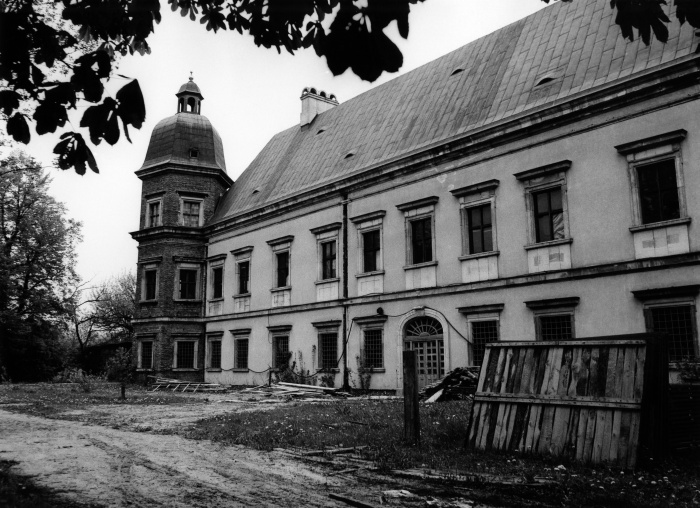
Zamek Ujazdowski, lata 80. Autor nieznany. Źródło: Archiwum CSW
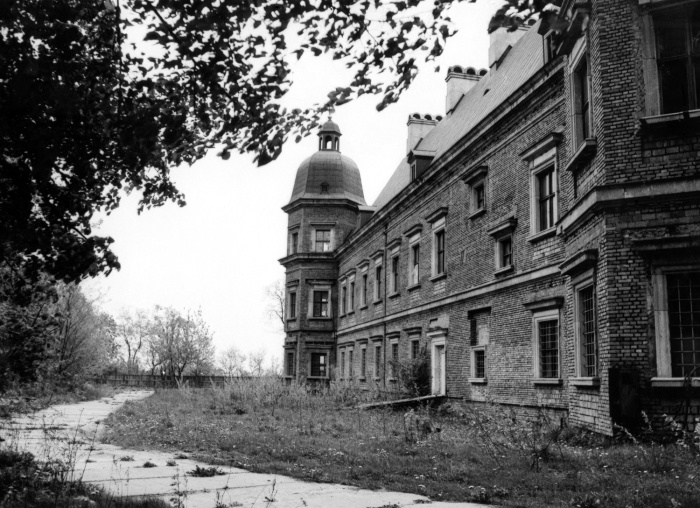
Zamek Ujazdowski, lata 80. Autor nieznany. Źródło: Archiwum CSW
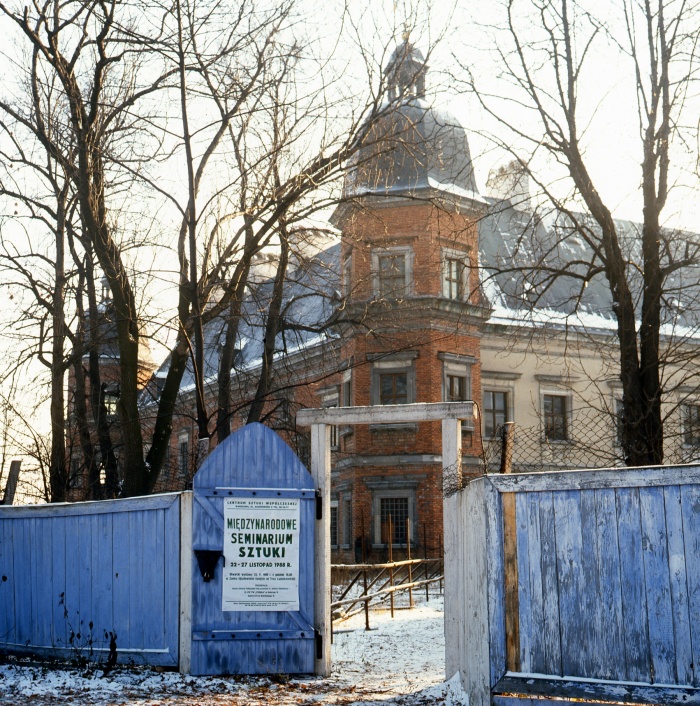
Zamek Ujazdowski, 1988. Fotografia: Wojciech Beszterda, Romuald Ereński. Źródło: Archiwum CSW
“I’m reconnoitering the area. The castle as the space of the Centre, as a construction site. I know already that these are the conditions in which I’ll be implementing my agenda. The place is haunted by ghosts of the recent past,” Wojciech Krukowski, author of a multidisciplinary concept for the Centre of Contemporary Art, a concept hammered out in process, simultaneously with the reconstruction2 of the building and the adaptation of its space, wrote about the year 1990. This author has been asked to analyze three exhibitions from the institution’s early history – to highlight that which the opening editorial calls a “performative institution”;3 to look at how the institution performs its role in the community and its own identity as a place where art is presented and mediated. Alas, the archives offer little information on audience-institution interactions, the area where performativity (in the sense that interests me, i.e., as an activated transference) is most fully realized.
The Centre, “housed at the Ujazdowski Castle and struggling with the contemporary art of building (the construction project has dragged on), is doing its best to pursue a highly ambitious and diverse program.”4 The CCA was founded in 1988. In June 1989, the chronology shows, there was a hiatus that continued until April 1990.5 Research. Interviews with guides, Castle staff members: Małgorzata Czyżewska, Monika Marchewka, and Grzegorz Borkowski. Browsing through the institution’s archive and the folders collected by the Center for Information and Documentation, the last, now defunct, institution devoted to current artistic life in Poland.6 The Castle is a space for questions about “modes of action suitable for establishing a relationship – effective contact – with the contemporary.”7 The latter began with the conceptual practices of the 1960s. In art, the Castle team was interested in a non-indifference approach to the socio-political reality and a reconciliation of the conceptual with the sensual. The rupture of 1989 was seen as a final act in this decomposition (a process begun by martial-law-era structural changes) of a distinct art system and institutional model based on clear hierarchies. According to Ewa Mikina, a curator, translator, and art historian working at the Castle at the time, “The linear and decontextualizing modernist philosophy of culture had collapsed.”8
The Centre was originally geared towards action art. Krukowski himself was the founder of the legendary alternative theater group, Akademia Ruchu, active in the 1980s at the Żytnia Street church in Warsaw, and of the Tęcza Cinema Theater. Visual arts, theater, film, music… Viewer interaction was also an important preoccupation. It was here that the Artistic Education Laboratory was established, a pioneering initiative committed not so much to the propaedeutics of the philosophy of art (an approach still adhered to by many public institutions in Poland) as to raising awareness and the mediation of art among different audiences. For example, in 1990, the Laboratory held the 1st International Workshop “Power for the Imagination,” dedicated to the artistic education of children.
“Three months into my tenure, the Centre for Contemporary Art is beginning to function smoothly, implementing a program of ‘presenting and making art in a process of changes.’”9 “I entrust the crucial portfolio – that of the curator of exhibitions and collections – to Ryszard Ziarkiewicz, the famed curator of a series of Neo-Expressionist shows in the late 1980s.”10 “This is important: I know that the trend, so important as a counterweight to established hierarchies in art and the political system, will soon begin to wane, is already waning. I hope for a worthy finalization of phenomena that, in the new reality, will doubtless be supplanted by new tendencies.”11 “We are investing all our energy to produce a monumental exhibition of 1980s Neo-Expressionism confronted with flagship examples of socialist realism, titled Paradise Lost.”12
“The confrontation of two utopian visions giving way to already discernible trends of a new era,”13 – and then Krukowski – “We live in a place where an oversensitivity to social issues should be appealing to us.”14 Subtitle: Polish Art in 1948 and 1949 – two dates: the decreeing of enslavement (socialist realism) and the decreeing of freedom. The originally proposed subtitle was What After Communism? 18 June – 31July 1990. An exhibition at the Ujazdowski Castle and Agrykola Park. Painting, sculpture, socialist-realist art, and posters. Kitschy realism (a selection from the storerooms at Kozłówka, where various institutions had been sending works since 1962; the key was a “contrast between idea and its realization”):15 Majer Appelbaum (Szczecin), Irena Brandl (Warsaw), Alfons Długosz (Kraków), Franciszek Hajduk (Szczecin), Vlastimil Hofman (Wrocław), Paweł Janusz Janowski (Warsaw), Józef Klimek (Kraków), Halina Kowalska-Krysińska (Radom), Alfred Lenica (Warsaw), Zofia Lipińska (Gdańsk), Irena Łuczyńska-Szymanowska (Warsaw), Włodzimierz Siwierski (Warsaw), Bolesław Stawiński (Katowice), Walentyna Symonowicz (Warsaw), Jan Świderski (Kraków), Jadwiga Walker (Warsaw), and Stefan Żechowski (Katowice). Besides the latter, shown in a separate space, all the others were presented together, in iconographic rhythms.
The curator wasn’t interested in doctrinism or decreed didacticism, “installed in art by outside factors, for ideological and administrative reasons,” nor in intellectual socialist-realist projects (e.g., Andrzej Wróblewski), but in “genuine emotions,” engagement, and popular potential. In the art of his generation he shows a direct reaction, the result of universal civil opposition to the regime’s policies. “The pulsation of reality, change, art’s duties” – romantic ideals, without the mention, for example, of a modernist function.16
In the catalog of an earlier exhibition, Expression of the 1980s, the curator makes it clear that he is interested in a “refusal to participate in a mass-scale scam.” Emotions and metaphysics: Tadeusz Boruta (Kraków), Maciej Dowgiałło (Warsaw), Edward Dwurnik (Warsaw), Jerzy Kalina (Warsaw), Grzegorz Klaman (Gdańsk), Łukasz Korolkiewicz (Warsaw), Aldona Mickiewicz (Kraków), Jarosław Modzelewski (Warsaw), Wiesław Obrzydowski (Kraków), Jacek Staniszewski (Gdańsk), Szymon Urbański (Warsaw), and Ryszard Woźniak (Warsaw). Each was given a separate space. At the time, commitment meant individual work rather than collective effort. Being independent means being alone. “Whereas the creators of the paradise are static [e.g., Marshal Rokossovsky, the subject of one of the portraits, who in 1954 ordered the Castle’s remnants to be demolished - Author], consolidated in eternal duration, their young apostles [the pioneers – Author] work hard on themselves. This was the meaning of that paradise – work and self-education,” a reviewer writes, analyzing the bodily compositions of the represented figures. “Paradise makes people equal, and equality is epitomized by the uniform. . . In a uniform . . . it is easiest to survive the ecstasy of initiation.”17
Ziarkiewicz showed Neo-Expressionism as a political figuration. Sometimes he was actually interested in the allegoric aspect of the movement. The exhibition was meant to settle accounts, and its narratives and reviews frequently referred to “morality” (Ziarkiewicz: “moral non-indifference”18). The curator wanted to speak up in the face of impending social shifts. “Ziarkiewicz’s exhibition, if we measure it in political terms, makes a stand on the ‘government of souls.’”19 As in 1949, there is a lot of talk about revolution.20 Paradise Lost is “in fact a provocation, an attempt to revaluate, from a new perspective, the achievements of postwar Polish art. . . . the idea is to escape the paralyzing vicious circle of entrenched hierarchies and outdated classifications.”21 Ziarkiewicz introduces a new understanding of realism: theme, not form. A return “to the theme, the subject matter.”22 The idea that art was isolated from the people was formulated by Tadeusz Dobrowolski in Odrodzenie in 1946. For György Lukács, realist art is one that allows the viewer to identify.
Expression of the 1980s is about revolt. Rotenberg: “Several crucial shifts have taken place in our understanding of the function of art and the mission of the artist as well as in artists’ preoccupations.”23 “Art . . . in the past decade [1980s – Author] was busy tracing its own grammar and expanding its boundaries to the point of merging with life.”[24] Sitkowska in a review for Obieg: “the show articulated spot-on a fundamental defect of postwar Polish art.”25 Ziarkiewicz sharply in a conversation with Koźbiel: “Students still think that abstraction is the aristocracy of art, and everything else is the plebs.”26 He sounds a more moderate note in the catalog introduction: “Abstraction absolves the sin of youthful infatuation with socialist realism, bringing you back to life and to Europe. No one cares, or perhaps no one notices, that the new art does not fit the socialist structure, which is retained intact.”27 What happens in Polish art after socialist realism, according to Ziarkiewicz, is modern aesthetics-influenced eclecticism combining an aversion to moral (sic!) and political reflection with a tendency towards formalism. In this exhibition, Ziarkiewicz’s third, the “harshness” (Sitkowska’s term) of the 1980s had evaporated. What remained was a generational revolt “against the lifestyle of the modernist monopolist.”28 The loss, therefore, is only apparent, with a whole new space emerging.
A dramaturgy of change is built by turning the exhibition space’s defects into an asset, sometimes of a virtually theatrical nature, as well as through the gradation of narrative tension, e.g., the accumulation of gestures in the rooms with socialist realism. With its austere interiors, the Castle itself brings to mind the church crypts that used to house art in the 1980s. “Within the unplastered walls of the Ujazdowski Castle, where floors haven’t been laid yet – strange paintings.”29 Bare concrete ceilings. Cast-iron heaters. Concrete floors, some lined with paving slabs, others with rough planks. Statues standing on plinths made of assorted bricks. The Castle’s present-day spaces can hardly be recognized in photographs from those days. “Jerzy Kalina is not only first but also very important. He is present in Paradise Lost at three significant places: in front of the entrance (The Gate),30 in the courtyard – the bitter Roll Call, dozens of shovels with handles covered with red paint, candles burning on the floor, and in the large room upstairs – the ironic Honor Lane: two rows of large tree trunks, those on the left topped with canopies of twinkle lights, those on the right covered with grey rags. Also important is Grzegorz Klaman: two objects at the foot of the slope and upstairs an ‘open-hearth furnace’ with mud-spattered Lenin volumes in its belly.”31 None of the reviewers seem to have noticed how the exhibition continued into the garden. One critic fumed that Ziarkiewicz had failed to show art interested in “penetrating the mystery of the world.”32 Marek Goździewski: “abstraction was meant to cause vibrations of the soul that produce knowledge (in the viewer).”33 Ziarkiewicz posited that art would be reborn with the death of abstraction, to which Goździewski replied that this was tantamount to calling for spiritual death, that abstraction was the essence of art and the living spirit its matter.
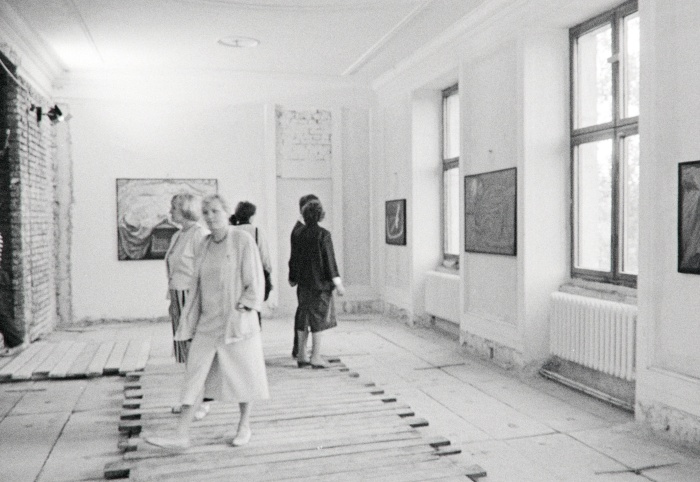
Wernisaż wystawy „Raj utracony. Sztuka polska w roku 1949 i w roku 1989”, 1990; Fotografia: Mariusz Michalski, Barbara Wójcik. Źródło: Archiwum CSW.
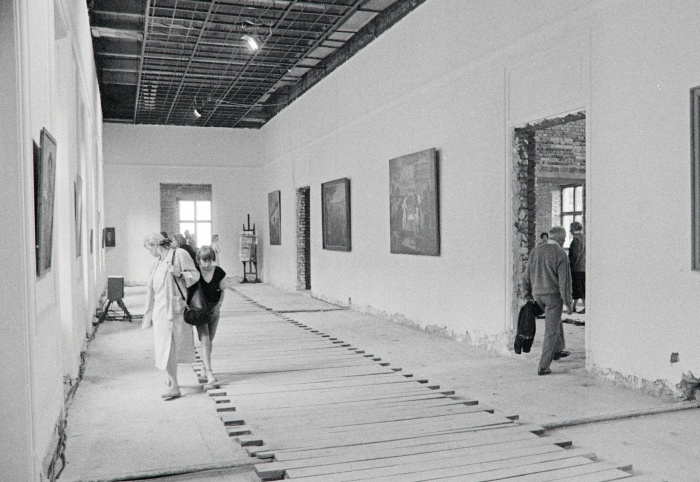
Wernisaż wystawy „Raj utracony. Sztuka polska w roku 1949 i w roku 1989”, 1990; Fotografia: Mariusz Michalski, Barbara Wójcik. Źródło: Archiwum CSW.
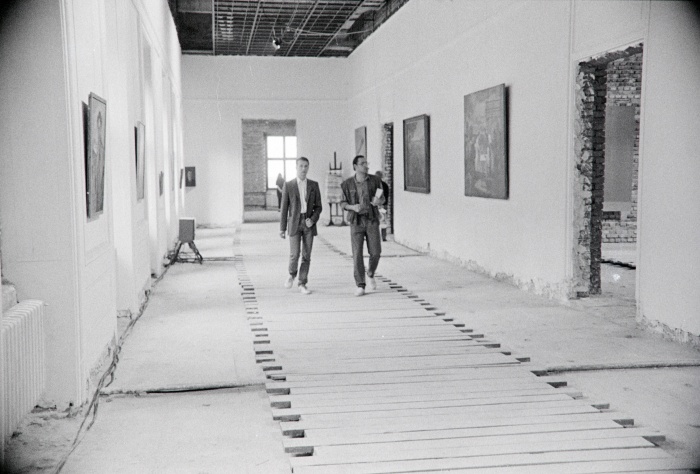
Wernisaż wystawy „Raj utracony. Sztuka polska w roku 1949 i w roku 1989”, 1990; Fotografia: Mariusz Michalski, Barbara Wójcik. Źródło: Archiwum CSW.
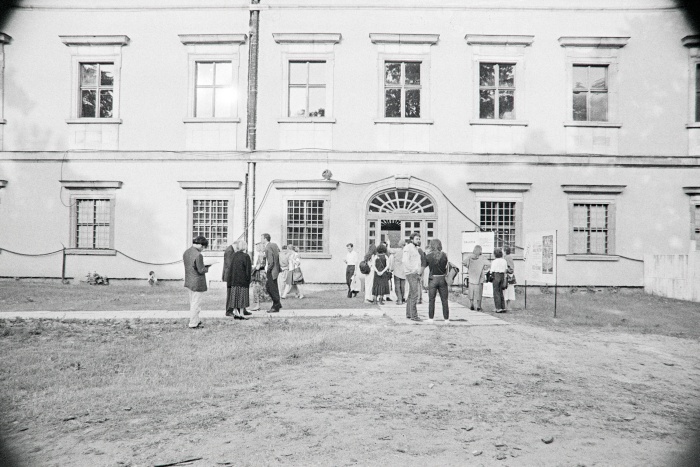
Wernisaż wystawy „Raj utracony. Sztuka polska w roku 1949 i w roku 1989”, 1990. Fotografia: Mariusz Michalski, Barbara Wójcik. Źródło: Archiwum CSW

Wernisaż wystawy „Raj utracony. Sztuka polska w roku 1949 i w roku 1989”, 1990. Fotografia: Mariusz Michalski, Barbara Wójcik. Źródło: Archiwum CSW
In the previously cited conversation about the Castle’s program, Ewa Mikina talks about art using the phrase “a grey zone of meaning.” Agata Bielik-Robson, in turn, reflects on the trends of the era, pointing to a spiritual need to search beyond Enlightenment dialectics; she diagnoses a condition of being “ill with meaning.”34 “The Romantic attitude is modern because it followed the Enlightenment. But it is its shadow. An indispensable one,” writes Bielik-Robson, rightly revising her earlier postmodern intuition. “It is a response to the project of radical enlightenment,” the philosopher writes, referring, let me add, to Polish socialist realism.
Underlying Romantic philosophy is a yearning for integral spirituality: “I construe spirituality broadly here – as any reflection on man’s place in the universe and his sense of existential orientation.”35 “It is a desire of, and longing for, feeling a strong bond with the world.”36 Bielik-Robson writes that a subject who has spiritual needs refuses to accept an irremovable fragmentation of life. He seeks totality, and the dream of it assumes the nostalgic form of a broken bond. The resulting resentment means that the existential condition balances on the verge of totalitarian security. The question is how to preserve modern democratic observance in romanticism; how to reconcile the conceptual with the sensual.
“That the Ujazdowski Castle has been turned into a Centre for Contemporary Art has been criticized by many. Indeed, the interiors seem kind of unsuitable for modern exhibitions. But not this time. Mystics and Magicians [sic!], the latest sculpture show, has blended perfectly with the background. Don’t miss it!”37 In conceiving Magicians and Mystics, Grzegorz Kowalski was inspired by Wojciech Karpiński’s book Pamięć Włoch [The Memory of Italy] and a Karl Vossler quote contained therein. (Consultation: Waldemar Baraniewski; organizational collaboration: Ewa Gorządek). 8 February – 3 March 1991, 33 artists. Some of the older works had come from the storage of the show’s co-organizer, the Polish Sculpture Center in Orońsko. Somewhere, someone noticed that in constructing his own artistic genealogy, Kowalski moved around a memory field to which he had eyewitness access. Four decades of artists comprising the avant-garde movement in Poland, with a tilt towards the Warsaw scene: Jacek Adamas (Warsaw), Paweł Althamer (Warsaw), Mirosław Bałka (Otwock), Krzysztof M. Bednarski (Italy), Jan Berdyszak (Poznań), Włodzimierz Borowski (Brwinów), Elżbieta Cieślar (France), Emil Cieślar (France), Barbara Falender (Wrocław), Wiktor Gutt (Warsaw), Władysław Hasior (Zakopane), Krystyn Jarnuszkiewicz (Warsaw), Jerzy Kalina (Warsaw), Marek Kijewski (Warsaw), Grzegorz Klaman (Warsaw), Grzegorz Kowalski (Warsaw), Mariusz Kruk (Poznań), Zofia Kulik (Warsaw), Piotr Kurka (Poznań), Przemysław Kwiek (Warsaw), Henryk Morel (Warsaw), Małgorzata Niedzielko (Białystok), Grzegorz Olech (Warsaw), Robert Rumas (Gdańsk), Mikołaj Smoczyński (Lublin), Jerzy Stajuda (Warsaw), Jacek Staniszewski (Gdańsk), Maciej Szańkowski (Warsaw), Lech Tomaszewski (Lublin), Daniel Wnuk (USA), Jan Stanisław Wojciechowski (Warsaw), Xawery Wolski (France), and Roman Woźniak (Płock).
Two types of spiritual existence, meeting in one being – the author. Mystics free themselves from forms, creating new ones. They are “eternal hunters of unassimilated meanings.”38 Magicians use language as a tool, claiming power over reality. They are the “polishers of forms,”39 even at the cost of losing the original message from sight. The exhibition asks questions about the social role of the artist, and everything precisely laid out in the catalog. Still, the critics obviously had a problem: rather than writing about the relational form of the show or commenting on the individual works, they tended to ponder over issues like whether the magician is a fraudster.40 “Convention required that the exhibition be clearly defined in terms of genre, and the multiformity of the exhibits and certain affinities with the installation tradition caused it to be classified as a sculpture show.”41 “The works are all kinds of objects, each of which needs to be differently defined. The show has been perfectly arranged. It consists of separate spaces, precisely and accessibly discussed in the catalog.”42 A few smarter critics note that this is not your typical – usually boring – post-retreat show, and that what is seen in it depends on the spectator’s predispositions; that the exhibition serves to open up the imagination. From today’s perspective it seems clear that it raised the question of how two forms of existence cohabit in the artist and manifest themselves in art, operating a material, three-dimensional solid.
The exhibition was all about mood – “it was like a lyric poem.”43 In the catalog introduction, Kowalski stresses that the idea was to show an insider’s view of art, a view from the perspective of the artist, to share with the public the essence of the creative act, fuelled as it was by instinct (intuition) or intellect. He invited artists who, working with their own respective styles, met the challenge posed by form itself: artists who perfected themselves, going beyond their own creative paradigm; who were interested in what happens between vision and language, between the requirements of the work’s materiality and its perfect embodiment, deposited in the imagination. “The mystics, satisfied with an imaginary being, will reject the material shape, while the magicians will be searching for a medium to convey a product of the imagination.”44 Some succumb to the metaphysics of sculptural matter, for others materiality is an inconvenient condition, one that needs to be minimized, ignored, denied. My favorite works from the show include, for example, Krzysztof Bednarski’s collection of voodoo fetishes; Mikołaj Smoczyński’s Painting (1990), a triangular piece of paper (?) on the wall; or Ship Stranded Off the Coast of Czechia (1968) by Jerzy Stajuda, an artist who during the People’s Poland era assembled models for the drawer. As a perfect example of such transgressive art the catalog mentioned Jacek Sempoliński (himself absent from the show), according to whom death is the real transgression, and everything else but worldly translocation. Art itself carries the allure of achieving a state that has no equivalent in the sensual reality – a feeling of substantiality.45
Isolated initiatives in the space around the Castle appear from 1990, e.g., the sculptures by Klaman and Kalina in Paradise Lost. A regular program of exhibitions in front of the Castle kicks off in 1992 with Dan Richter-Levin’s Wooden Spatial Composition. In 1993, Maria Eichhorn stages an event called Plastering of the Ujazdowski Castle’s Façade Completed (curator: Milada Ślizińska, 19 November 1993 – 1 January 1994). As soon as the construction works directly in front of the CCA cease, the outdoor sculpture park moves to the courtyard or disappears. The program ossifies, with emphasis shifted from the institution’s daily activity amid the broader context to exhibition and festival projects.
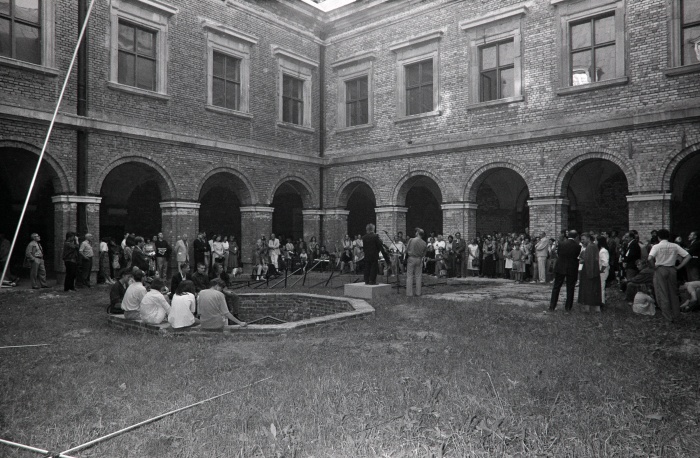
Wernisaż wystawy „Redukta”, 1991. Fotografia: Mariusz Michalski, Barbara Wójcik. Źródło: Archiwum CSW
While in 1995 the Web emerges as a space of artistic and curatorial practices, the first steps around the collection hearken back to originary thinking about the institution’s shape as defined in purely physical terms. Working on the CCA’s first exhibition, Piotr Rypson, Jarosław Kozłowski, and Wojciech Krukowski used a metaphor, dictated by the Castle’s very layout, of outlines and corners. The act of collecting was also governed by a certain organicity: the CCA collected only those works that it had previously exhibited. Artists were invited to relate to the extant situation: Richard Nonas interpreted the Castle in its utterly crude spaces. Lawrence Weiner’s Far Too Many Things to Fit Into so Small a Box (1996) an inscription on the façade, painted over in recent years in unclear circumstances, perfectly encapsulated a spatial, though not expansive, institutional strategy.
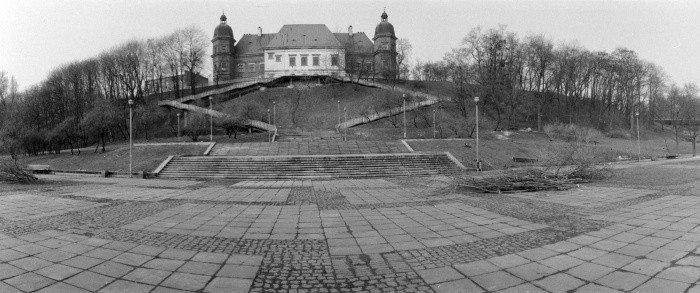
Zamek Ujazdowski, 1991. Fotografia: Mariusz Michalski, Barbara Wójcik. Źródło: Archiwum CSW
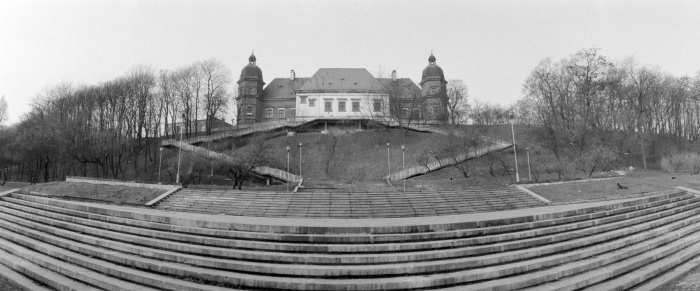
Zamek Ujazdowski, 1991. Fotografia: Mariusz Michalski, Barbara Wójcik. Źródło: Archiwum CSW
Crossroads of Sculpture I and II were the third and fourth exhibitions in the park at Plac na Rozdrożu. Crossroads of Sculpture I: 27 November 1992 – 30 May 1993. Jacek Adamas (Warsaw), Tomasz Domański (Wrocław), Jarosław Hulbój (Poznań), Michał Mielnik (Nałęczów), and Marek Sienkiewicz (Wrocław). Sculpture, objects. Crossroads of Sculpture II: 2 July – 30 May 1994/5?46 Paweł Althamer (Warsaw), John Blake (GB/NL/USA), Michał Mielnik (Nałęczów), Emma Posey (GB), Łukasz Skąpski (Kraków), and Marek Sułek (Warsaw). Sculpture. Works incorporating earth, steel, or concrete are of an “almost heroic nature,” the curator writes in a leaflet accompanying the first edition, and no reviews or press reports have been preserved. The title alludes to the name of the public square adjoining the Castle, but above all to sculpture’s relationship with architecture and the landscape. The successive shows were meant to reflect on those issues more deeply or differently.
In the text, Anxious over the Identity of Sculpture, Marek Goździewski, the curator of Crossroads, wrote about the features of the then-hot, entropic-organic change: absence of figuration, minimalism, and most importantly, the replacement of the representation by the living person (sometimes the artist and his body, most often the public).47 The artists practice sculpture and drawing at the same time; they are interested in spatializing flat areas. They reject an excess of means of expression. Young sculpture calms down. Rhythms and organicity. “Naturalism and brutality under geometric discipline.”48 What matters is feeling: traces, processes.
“It was work in the context of an institution-in-the-making and a building being reconstructed.” I talk to Jarosław Hulbój over the telephone. “The surroundings had no context and were an influence. The park was an out-of-the-way place, far from any pedestrian routes. The reconstruction had been taking ages, a dragging-on situation. A kind of construction site. I don’t really remember what formula had been presented to us. The idea was to give the place a distinct identity. To attract the attention of the park goers and make them enter. I think the whole thing came about through my meeting Marek Goździewski at the Places Non-Places exhibition in Orońsko. Organized by Jan Berdyszak, the show presented the artistic propositions of art students, selected by a nominating committee and representing all of Poland’s art schools at the time; it was the first edition of what is known today as the Young Triennale. When I arrived, one piece was already there, I guess it was by Domański, something that continued into the ground. Ah, and those ribs, like. We probably went there each at a different time – when I was executing my project, there were no other artists there. I don’t even remember attending the opening; whether there was one at all or if things simply began to exist and function in space organically. As an anecdote I can tell you what the production process looked like. We had all trained as sculptors. Sculptors make do. I was prepared. Of course, a study visit first, since this would be a site-specific piece. About a month earlier I’d sent a list of what I needed: two planks two meters long each, one three and a half to four meters long, and one five meters long. Plus a shovel. That was all I needed, and I’d assemble the work myself. So here I come. They start looking for the planks, find the two shorter ones and the longer one, but can’t find the five-meter one. I am told to wait until tomorrow, everybody’s already gone home, but I have no time, tomorrow I need to hit the road again. I decide to get the plank myself. I was given an address of a sawmill, far off in the outskirts of a city I didn’t know. It took me an hour by tram to get there. I chose a plank and rented a cargo taxi to bring it to the Castle. The ratio was such that the plank cost, say, 50 zlotys, and the taxi 500 [laughs]. Three interventions using planks and earth in three different places, set by trees a little apart from each other. A piece of turf cut out of the ground and pressed horizontally against a tree using a long plank, the trace left by it remaining intact. A plank pushed into the ground, into the turf, supporting a stooping tree. Two planks with turf situated very close to each other between trunks. Working with matter in space, a bit like gardening, a bit like spatial design, but the context detached from practical usefulness. Rather, the idea was to create a vague sense of tension. An entropic situation.” An interesting theme, particularly when we think of a recent work by Teresa Murak, who heaped up earth by the Castle that had been dug out during the construction of the Warsaw metro or that had been removed during maintenance work or tree felling.
The construction of the CCA unfolds in time. The institution is interested in all the participants of the process. The shell-condition building inspires artists. Published in 1992, the first issue of Gazeta Orońsko initiates a discussion on what the art presented at “splendid locations” can offer to the public at large. Emotional and sensorial practices are widely advocated. In a series of essays published in Res Publica Nowa, “To Know in Order to See” (pity it’s not the other way around), Bohdan Paczowski suggests that art institutions should teach people to “breathe with their eyes” so that they can “discover forms or schemes usually invisible or ignored,” can “enjoy the grayness of dust.” He praises Wojciech Karpiński’s book about Czapski: “to learn how to see and to teach that to others,”49 and introduces Pierre Bourdieu’s concept of habitus to reflection on Polish society, pointing out the need to develop tools that will help prepare citizens for willing participation in culture. Krukowski: “In Poland we very much need a place where art would be shown in the process of its changes. We present things that are new to us too, thus educating not only others but also, and in the first place, ourselves. Nor do we want to cultivate things of the past.”50
Translated from the Polish by Marcin Wawrzyńczak
Cover photo: Ujazdowski Castle, 1988. Photo: Wojciech Beszterda, Romuald Ereński. Source: Archives of CAA Ujazdowski Castle
[1] This text's title comes from: Ewa Mikina, in “Zamek w budowie. Z Ewą Mikiną, Wojciechem Krukowskim i Piotrem Rypsonem rozmawiają Bogusław Deptuła i Piotr Gruszczyński,” Res Publica Nowa, 1997, no. 1-2, p. 55–59.
[2] The original castle was demolished in 1954, except for the basements. The authorities planned to build an army theater and a night school of Marxism-Leninism, but the project fell through. In 1961–1965, the preserved fragments underwent conservation. In the 1970s, during the construction of the Trasa Łazienkowska thoroughfare, the decision was made to reconstruct the building.
[3] Wojciech Krukowski, Tyle lat co Polska Ludowa albo 45 lat od wtorku, Warszawa, 2015, p. 195.
[4] (wk), “Magowie i Mistycy. Awangarda w Zamku Ujazdowskim,” Życie Warszawy, February 8, 1991 (press clipping, CCA archive).
[5] Cf. Centrum Sztuki Współczesnej Zamek Ujazdowski w Warszawie 1988–1998, multiple authors, Warszawa, 1999.
[6] “Center” stood for an artist community that also included art critics (Obieg). “Information” is a nod to the very ideas of exchange. “Documentation” means monitoring all kinds of publications, including ephemera. The name – like that of the Centre for Contemporary Art – pointed to the institution’s foundations.
[7] Mikina in: “Zamek w budowie…,” op. cit.
[8] Ibid.
[9] Krukowski, Tyle lat…, op. cit., p. 196.
[10] Expression of the 1980s, BWA Sopot, 5 June – 31 July 1986, Radical Realism, Concrete Abstraction, National Museum, Warsaw, 14 December 1987 – 31 January 1988, and Paradise Lost were an exhibition triptych devoted to the phenomenon of Neo-Expressionism, curated by Ryszard Ziarkiewicz, a critic and curator based in Gdańsk in the 1980s and 1990s, publisher and chief editor of the Magazyn Sztuki quarterly, Poland’s leading art periodical alongside Obieg in the 1990s.
[11] Krukowski, Tyle lat…, op. cit., p. 193–194.
[12] Ibid., 197.
[13] Ibid.
[14] Mikina in: “Zamek w budowie…,” op. cit. It is the Castle that gradually introduces critical art. Katarzyna Kozyra’s Animal Pyramid, shown in Ideas Beyond Ideology (10 December 1993 – 30 January 1994), caused the first major scandal. An interesting paradigm shift occurred in the 1990s, from entropic art, sending a fuzzy, sensual message, to more straightforward, sometimes virtually propagandistic productions.
[15] Jan Koźbiel, “Powrót do raju? Rozmowa z Ryszardem Ziarkiewiczem,” Obieg, 1990, no. 6.
[16] This and further quotations in this paragraph: M. Sitkowska, ed., Ekspresja lat 80., exh. cat.
[17] ba, bt, Polityka, 1990, no. 29 (press clipping, CCA archive).
[18] Ryszard Ziarkiewicz, “Wprowadzenie,” in: Raj utracony, exh. cat., Warszawa, 1990, p. 5.
[19] Maryla Sitkowska, “Obrzeża raju,” Obieg, 1990, no. 7.
[20] Koźbiel, “Powrót do raju?” op. cit. Cf. Krukowski, Tyle lat…, op. cit.
[21] Jan Koźbiel, “Wywołanie wilka,” Exit, 1990, no. 3, p. 79–81
[22] Jan Koźbiel, “Powrót do raju?” op. cit.
[23] Anda Rottenberg, “Przekroczenie” (1987), in: eadem, Przeciąg. Teksty o polskiej sztuce lat 80., Warszawa, 2009, p. 270.
[24] Ibid., p. 268.
[25] Sitkowska, “Obrzeża raju,” op. cit.
[26] Koźbiel, “Powrót do raju?” op. cit.
[27] This and further quotations in this paragraph: Ziarkiewicz, “Wprowadzenie,” op. cit., p. 5.
[28] Ibid.
[29] ba, “Raj utracony, czyli drugie pożegnanie,” Konfrontacje, August 12, 1990 (press clipping, CCA archive).
[30] Built with stacks of newspapers.
[31] Jan Koźbiel, “Wywołanie wilka,” op, cit.
[32] Marek Goździewski, “Jeszcze o Raju,” Obieg, 1990, no. 8.
[33] Ibid.
[34] Agata Bielik-Robson, “omantyczne dopełnienie. Komentarz do epifanii nowoczesnej Charlesa Taylora,” Res Publica Nowa, 1998, no. 7–8, p. 26–39.
[35] Ibid.
[36] Ibid.
[37] ba, “Prasałki,” Na Przełaj, March 10, 1991 (press clipping, CCA archive).
[38] Ibid.
[39] Ibid.
[40] Małgorzata Biernacka, “Zinterpretuj to sam,” Gazeta Wyborcza, February 19, 1991 (press clipping, CCA archive).
[41] This and further quotations: (wk), Magowie i Mistycy, op. cit.
[42] Ibid.
[43] Dorota Jarecka, “Magowie i Mistycy,” Magazyn Artystyczny, 1991, no. 8.
[44] Grzegorz Kowalski, in: Magowie i Mistycy, exh. cat., CSW Zamek Ujazdowski, Warszawa, 1991.
[45] Maryla Sitkowska, “Genealogia przyszłej rzeźby polskiej,” in: ibid.
[46] Centrum Sztuki Współczesnej Zamek Ujazdowski w Warszawie 1988–1998, op. cit., pp. 42 and 52 – different dates are mentioned.
[47] Marek Goździewski, “Niepokój o tożsamość rzeźby,” Gazeta Orońsko, 1992, no. 1, p. 8–9.
[48] Ibid.
[49] Bohdan Paczowski, “Muzeum w demokracji. Grób czy skarb? Świątynia czy szkoła?,” Res Publica Nowa, 1996, no. 7/8, p. 67–74.
[50] “Zamek w budowie…,” op. cit., p. 55–59.



